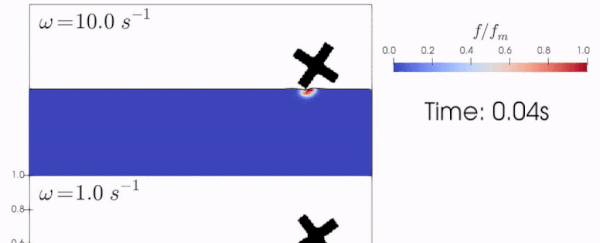You might not know the term 'oobleck', but it's highly likely you came across it as a kid. Also known as a non-Newtonian fluid, the strange material sometimes behaves like a liquid, and sometimes acts like a solid. It's usually made of corn-starch and water, and it produces hours of fun for children everywhere.
Punch it and it seems to be solid, but try to pick it up slowly and it dribbles down your fingers.
But how does it actually work? And how do you predict how something will move through it?
Researchers at MIT have taken a deep dive into the magic ooze, and recently published a 3D mathematical model that's capable of predicting when oobleck is going to change from a solid to a liquid and back again.
 (A. Baumgarten, K. Kamrin, and J. Bales)
(A. Baumgarten, K. Kamrin, and J. Bales)
"Fine-particle suspensions (such as cornstarch mixed with water) exhibit dramatic changes in viscosity when sheared, producing fascinating behaviours that captivate children and rheologists alike," the researchers explain.
"In this work, we introduce a predictive and general, 3D continuum model for this material, using mixture theory to couple the fluid and particle phases."
The name 'oobleck' came from the green goo in Dr Seuss' book Bartholomew and the Oobleck. But it's not just a marvel for kids - the material has long fascinated scientists thanks to the way it behaves differently depending on how you interact with it.
The reason why non-Newtonian fluids have this ability is due to the size of the particles themselves. For example, corn starch particles are only a tiny fraction of the size of a grain of sand, and because they are so small they can be influenced by temperature and electric charges which build up around the particles.
If you move slowly through oobleck, the grains repel each other and will slide gently. But if you hit the liquid fast, the particles touch and the friction creates the solid-like consistency.
"It's a simple material to make - you go to the grocery store, buy cornstarch, then turn on your faucet," says Ken Kamrin, a mechanical engineer at MIT. "But it turns out the rules that govern how this material flows are very nuanced."
The team had already been working on a model for wet sand, but had to modify it to get all the variables for oobleck.
To figure out if they'd nailed their oobleck model and it matched up to the real world, they simulated experiments that have previously been performed on non-Newtonian fluid - such as squeezing oobleck between plates and shooting a projectile into a tank filled with the stuff.
Then, to see how their model would predict oobleck's behaviours, they simulated an X-shaped wheel running over the material at different speeds.
You can see a GIF of what that simulation looks like below.
 (Baumgarten & Kamrin, PNAS, 2019)
(Baumgarten & Kamrin, PNAS, 2019)
Their model was able to predict when the oobleck would change from a liquid to a solid, and then back again, as the wheel rolled over it.
Although this research is mostly a bit of fun, the researchers do think that they may be able to use this modelling for testing oobleck for things like bulletproof vests of potholes.
But the real question – can oobleck stop a bullet, has been spectacularly answered in this video below.
The research has been published at PNAS.
